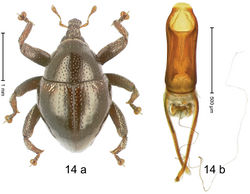Trigonopterus basalis
| Notice: | This page is derived from the original publication listed below, whose author(s) should always be credited. Further contributors may edit and improve the content of this page and, consequently, need to be credited as well (see page history). Any assessment of factual correctness requires a careful review of the original article as well as of subsequent contributions.
If you are uncertain whether your planned contribution is correct or not, we suggest that you use the associated discussion page instead of editing the page directly. This page should be cited as follows (rationale):
Citation formats to copy and paste
BibTeX: @article{Riedel2013ZooKeys280, RIS/ Endnote: TY - JOUR Wikipedia/ Citizendium: <ref name="Riedel2013ZooKeys280">{{Citation See also the citation download page at the journal. |
Ordo: Coleoptera
Familia: Curculionidae
Genus: Trigonopterus
Name
Trigonopterus basalis Riedel sp. n. – Wikispecies link – ZooBank link – Pensoft Profile
Diagnostic description
Holotype, male (Fig. 14a). Length 2.42 mm. Color black; base of elytra and legs ferruginous; antenna light ferruginous. Body subovate; in dorsal aspect with marked constriction between pronotum and elytron; in profile almost evenly convex. Rostrum dorsally scabrous, basally with indistinct median ridge; epistome forming angulate ridge. Pronotum moderately densely punctate. Elytra with striae marked by small punctures; interval 4 basally with cluster of few subovate, cream-colored, recumbent scales; interval 7 subapically forming indistinct ridge. Meso- and metafemur with anteroventral ridge weakly dentate. Meso- and metatibia in basal half widened, subapically narrowed; dorsal edge basally granulate; uncus large, peg-shaped. Metafemur with denticulate dorsoposterior edge, subapically without stridulatory patch. Aedeagus (Fig. 14b) with sides of body in apical third converging, apex rounded; orifice retracted; endophallus denticulate; transfer apparatus symmetrical; ductus ejaculatorius without bulbus. Intraspecific variation. Length 1.98–2.48 mm. Female rostrum dorsally subglabrous in apical half, with small punctures, epistome simple.
Material examined
Holotype (MZB): ARC0523 (EMBL # FN429229), WEST NEW GUINEA, Jayapura Reg., Cyclops Mts, Sentani, S02°31.912', E140°30.416', 785 m, 02-XII-2007, sifted. Paratypes (SMNK, ZSM): WEST NEW GUINEA, Jayapura Reg., Cyclops Mts: 4 exx, ARC0524 (EMBL # FN429230), same data as holotype; 16 exx, ARC0532 (EMBL # FN429238), Doyo, S02°32.478', E140°28.835', 365 m, 27-XI-2007, sifted; 2 exx, Sentani, S02°32.031', E140°30.412', 710 m, 02-XII-2007, sifted; 5 exx (1 marked “ARC0105”), Sentani, 600 m, 22-XII-2004, sifted; 1 ex, Sentani, 700 m, 22-XII-2004, sifted; 17 exx, Sentani, S02°32.221', E140°30.526', 575 m, 19-XI-2007, sifted; 1 ex, Sentani, S02°32.166' E140°30.512', 620 m, 19-XI-2007, sifted; 3 exx, Sentani, S02°32.291', E140°30.505', 515 m, 19-XI-2007, sifted.
Distribution
Jayapura Reg. (Cyclops Mts). Elevation: 365–785 m.
Biology
Sifted from leaf litter in primary forest.
Etymology
This epithet is based on the Latin adjective basalis (characterized by the base) and refers to the elytral base differing in color and vestiture from the remainder.
Notes
Trigonopterus basalis Riedel, sp. n. was coded as “Trigonopterus sp. 42” by Riedel et al. (2010)[1] and Tänzler et al. (2012)[2], respectively “Trigonopterus spap” in the EMBL/GenBank/DDBJ databases.
Original Description
- Riedel, A; Sagata, K; Surbakti, S; Rene Tänzler, ; Michael Balke, ; 2013: One hundred and one new species of Trigonopterus weevils from New Guinea ZooKeys, 280: 1-150. doi
Other References
- ↑ Riedel A, Daawia D, Balke M (2010) Deep cox1 divergence and hyperdiversity of Trigonopterus weevils in a New Guinea mountain range (Coleoptera, Curculionidae). Zoologica Scripta, 39 (1): 63-74. doi: 10.1111/j.1463-6409.2009.00404.x
- ↑ Tänzler R, Sagata K, Surbakti S, Balke M, Riedel A (2012) DNA barcoding for community ecology - how to tackle a hyperdiverse, mostly undescribed Melanesian fauna. PLoS ONE 7 (1): e28832. doi: 10.1371/journal.pone.0028832
Images
|
